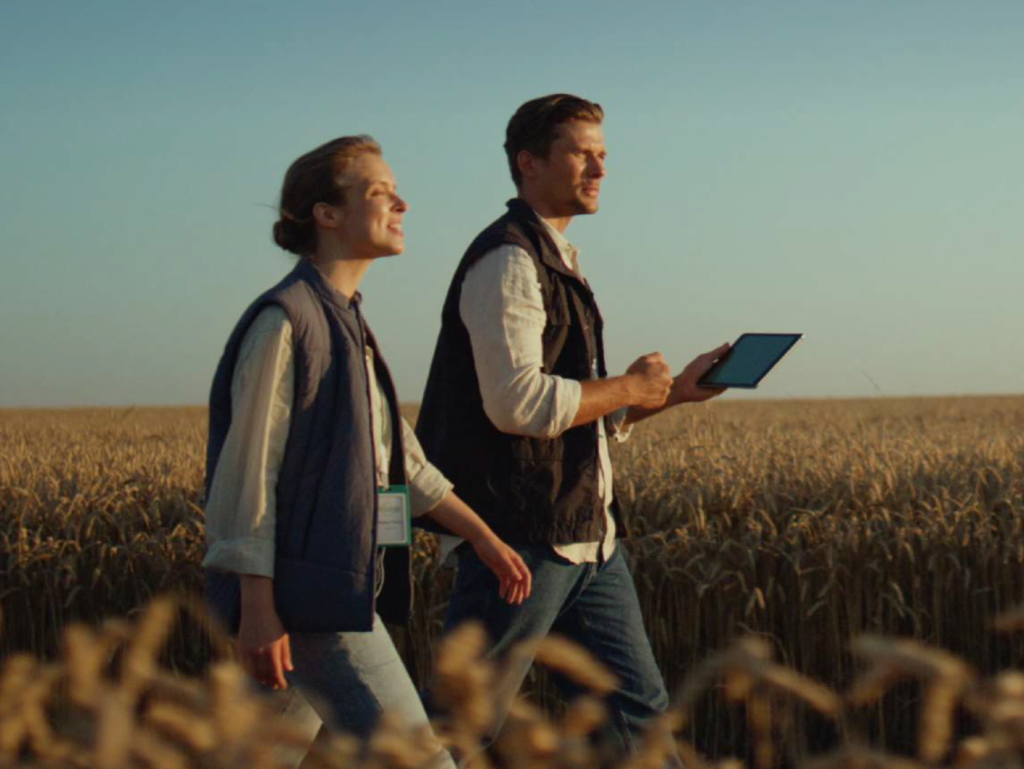Project Insights Report
Digital Technologies and the Big Data Revolution in the Canadian Agricultural Sector
 Executive Summary
Executive Summary
The Internet of Things (IoT) has had a profound impact on almost all production processes and areas of the economy, including household appliances, communication devices, financial services, energy, health care, manufacturing and agriculture, primarily through the capacity to collect data and automate a number of aspects of the production process.
The IoT refers to a network that connects physical devices to one another through the internet, using sensors, software and other technologies. In the context of agriculture, the use of the IoT has led to “smart farms.” Smart farming makes use of remote sensing devices in agricultural equipment such as tractors and planting equipment, as well as combines in the grain and oilseed industries, and in industrial-sized milking machines and ear tags in the dairy, beef, swine and poultry industries. The collection of data through these devices produces relatively small sets of data from individual farmers, which, when aggregated, become big agricultural data.
The benefits of smart farming and the use of these data sets include increasing the yield of crops while reducing water consumption and transportation costs. And while data collection provides value, it also creates a set of problems and challenges, including concerns around privacy, security, data ownership and competition between producers—as well as the transformation of work. This research demonstrates that despite the benefits, farmers have a number of concerns that translate into a lack of trust in the technology.
Researchers at the University of Saskatchewan’s Canadian Centre for the Study of Co-operatives reviewed the literature to examine the response in Canada and elsewhere by farmers, agribusiness firms, agricultural organizations and governments to the emergence of big data generated by the use of the IoT in agricultural production processes. Based on this review, the paper recommends actions that the system’s actors should take, which include roles for government, technology firms, and agricultural producers and farmers.
Key Insights
Smart farming promises advancements in agricultural productivity, reduced environmental impact, greater food security and enhanced long-term sustainability.
To address farmers’ reluctance to share data due to privacy and competition concerns, solutions include the development of data-sharing and protection protocols that are either voluntary or introduced by the government, or a member-owned body that uses a co-op governance model.
Voluntary agricultural data agreements have been developed between farming organizations and technology firms—often facilitated by governments—in the United States, New Zealand, Australia and the 27 member states of the European Union.
 The Issue
The Issue
As the country moves further into the 21st century, which will be characterized by continuing climate change, environmental degradation and population growth, demands on agricultural yield will increase. This has led to predictions that agricultural production will be powered by AI-driven cognitive computing and a technologically skilled agricultural workforce.
Alongside the argument that such changes are necessary, farmers’ distrust in the technology and the uses to which their data will be put are preventing smart farming from widespread adoption. While smart farming may bring benefits, farmers’ concerns about the potential changes to the process of farming and the nature of its work translate into an unwillingness to purchase “smart” farming equipment.
Proponents of the development of smart farms argue that now is the time Canada must act if it wishes to be a global agricultural exporter while yielding more food for an increasing population and cutting greenhouse gas emissions at the same time.
This paper addresses the nature of farmers’ concerns and prescribes a number of policy options regarding the use, management and protection of agricultural data that may allay farmers’ concerns.

 What We Investigated
What We Investigated
The purpose of this report is to:
1. present the opportunities that big agricultural data provide;
2. discuss the challenges related to big agricultural data and how they have been addressed to date;
3. identify some of the ways that governments and the agricultural industry, particularly farmers, could respond to such concerns in the future.
The paper’s authors review industry publications, the business press and the academic literature to examine the response in Canada and elsewhere by farmers, agribusiness firms, agricultural organizations and governments to the emergence of digital technologies. An underlying premise of this report is that big agricultural data could be transformational—the changes could be systemic and affect all aspects of the agriculture and food system, including the nature of farm work in primary agriculture.
 What We’re Learning
What We’re Learning
Big agricultural data development has been very rapid and forms the basis of the strategic plans of the world’s largest farm equipment manufacturers (e.g., John Deere), seed and chemical companies (e.g., Bayer, Syngenta) and information technology firms (e.g., Amazon, Google).
However, farmers lack trust in the technology and the potential uses to which their own data will be put. Farmers also hold concerns about a lack of competition among agricultural technology providers (the traditional holders of such aggregated data sets, known as ATPs), as well as whether big data will fundamentally change the nature of their work on the farm. To alleviate these concerns and create confidence in the process, technology providers and farm organizations—and in some cases, government—have created voluntary codes of practice for the use and sharing of agricultural data.
The increased value of agricultural data (at both the individual and aggregated levels), lack of legislative and regulatory frameworks, and complexity and inconsistency in contractual agreements all contribute to a tension between farmers and agribusiness around data issues and a reluctance by farmers to share data. The unwillingness to share data, whether it takes the form of a reluctance to purchase new equipment outfitted with smart sensors, or a reluctance to purchase or use the services of ATPs, prevents the benefits associated with data-driven agricultural practices.
To address farmers’ reluctance, the United States, Australia, New Zealand and the European Union have developed voluntary data management protocols. The European model that allows consumers generally to move their own data (“data portability”) in particular does not address the issue of the right of the farmer to protect their data or keep them private.
An alternative—and potential complement—to both voluntary agreements and data portability is the creation of data cooperatives. Cooperatives have a long history in agriculture, dating back to the late 1800s. A key reason for their creation is their ability to enhance competition in agricultural input and output markets, and to increase farmers’ trust in the system.
Although there are a few examples, agricultural data cooperatives have received very little attention as a way of dealing with the challenges and concerns. However, they represent a viable option that should be explored by Canadian policymakers.
 Why It Matters
Why It Matters
Because of the need to decrease carbon emissions and increase food production at the same time, proponents of smart farming argue it is the best way to grow more food with fewer resources. In particular, smart farming enables increased yield through more efficient use of natural resources and inputs; it also supports improved land and environmental management.
For example, smart farming helps farmers better understand water, topography, aspect, vegetation and soil types. This allows farmers to assess and manage these resources in economically and environmentally sustainable ways, and it increases the efficiency with which these resources are used. Farmers can then calibrate production processes in response.
While this is crucial to sustainably feeding the world’s growing population, smart farming provides other benefits for farmers and communities all around the world.

State of Skills:
Sustainable Jobs for Economic Growth
Green-related skills and knowledge are growing in significance and are becoming widespread across many sectors and occupations, requiring more workers to upskill by building upon their existing competencies.
Advocates argue that conventional supply chains have worked against the interests of farmers, insofar as farmers have fewer insights into how their products perform in terms of customer preferences and requirements. Smart farming provides a vital link between all players in the supply chain by enabling the efficient and equitable flow of information accessible to all the players in agricultural production. This could assist farmers by providing them access to information that supports better decision-making. Consequently, this has the potential to ensure a more equal distribution of profits to providers.
In smart farming, farmers’ use of smart technology generates small data—data sets produced by individual farmers. While small data has some value on its own, the real value emerges with the creation of “big data.” Big data is created when an ATP combines the data of many farmers with data from other sources (e.g., weather). These data can then be analyzed with proprietary algorithms to provide recommendations—e.g., the seed, fertilizer and chemical combinations to use on different land units—that can improve yields (increase agricultural production), environmental outcomes and/or economic returns.
 What’s Next
What’s Next
Next steps for this project involve conversations about the potential governance and ownership models by which data can be protected and shared. The report, however, recommends the following:
- The major players in Canadian agriculture should develop a voluntary code of practice for the use and sharing of agricultural data. While a voluntary code will not solve competition and trust problems, it is considered a necessary first step.
- Data portability, even if it were applied to farmers as business owners, is insufficient to address farmers’ concerns around competition. Other mechanisms are required to address this issue.
- Cooperatives should be actively investigated as a way of increasing competition and creating trust in big agricultural data. The creation of agricultural data cooperatives will require the involvement of numerous actors, including researchers, co-op developers, farm leaders, existing farm organizations and businesses, and federal and provincial policymakers.
- Governments must balance their involvement in co-op development. While they must not be indifferent, they must also try not to exert undue control.
- Co-op proponents will need to be attuned to the technological issues around big agricultural data, and they will need to pay attention to a social and legislative environment in which data sovereignty, security and privacy issues are changing rapidly.
More from FSC
AspireAtlantic
Indigenous Institutes
The Autonomous Microfactory: Skills Development Training Program
Have questions about our work? Do you need access to a report in English or French? Please contact communications@fsc-ccf.ca.
Digital Technologies and the Big Data Revolution in the Canadian Agricultural Sector is funded by the Government of Canada’s Future Skills Program. The opinions and interpretations in this publication are those of the author and do not necessarily reflect those of the Government of Canada.




